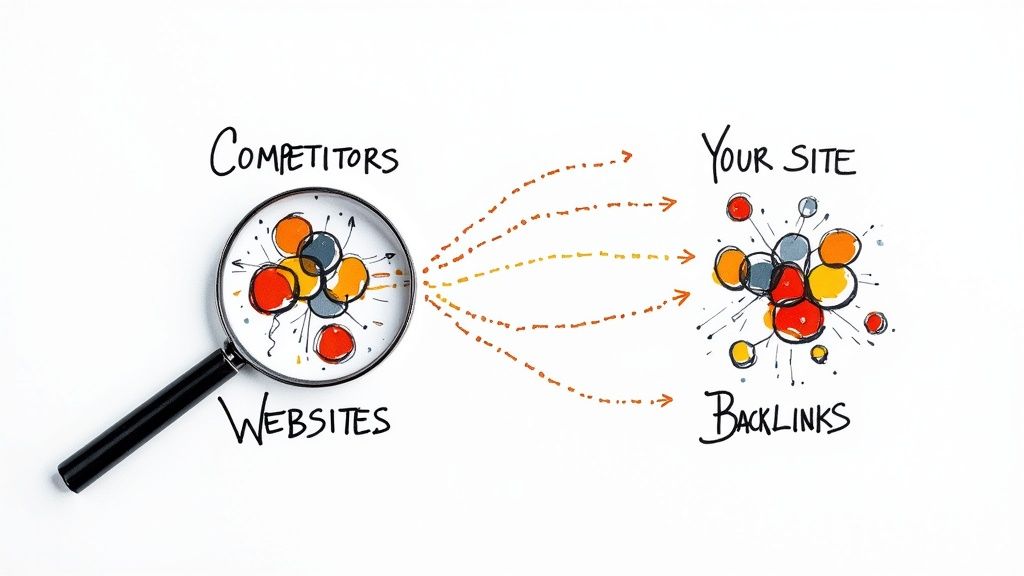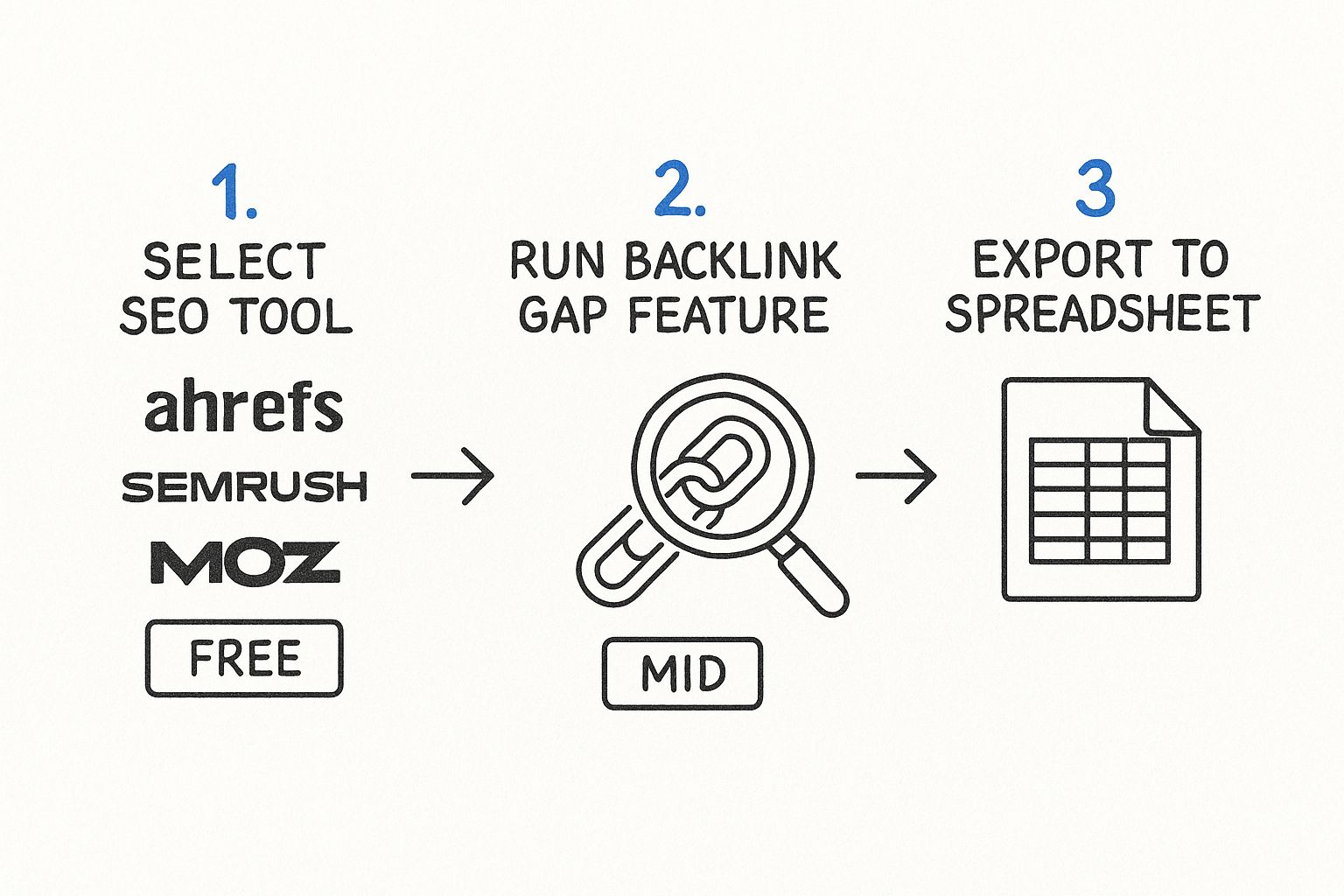Mastering Backlink Gap Analysis to Outrank Competitors

Maxime Dupré
10/15/2025

Think of it this way: a backlink gap analysis is basically SEO espionage. You're systematically figuring out which websites link to your competitors but don't yet link to you. It's a smart, efficient way to find red-hot link-building opportunities by simply seeing what's already working for the other players in your field.
Why Backlink Gap Analysis Is Your SEO Superpower

Your competitors have likely spent years, and a ton of money, building relationships and earning links that got them where they are today. A backlink gap analysis hands you their playbook. Instead of guessing where to get links, you get a proven roadmap of sites that are already interested in your industry. They're pre-qualified prospects.
This isn't about just blindly copying what your rivals do. It's about surgically dissecting the link landscape in your niche to understand what moves the needle. When you know who links to whom, you can stop wasting time and start investing your resources where they’ll have the biggest impact.
This kind of analysis is a cornerstone of a much bigger picture. To really get ahead, it's not enough to know what your competitors are up to; you need to understand why. If you want to go deeper on that, you should check out our guide on what is competitive intelligence.
To really drive home the value, let's look at the strategic advantages this analysis provides. It's not just about getting more links; it's about building a stronger, more resilient online presence.
Key Benefits of Backlink Gap Analysis
| Benefit | Strategic Impact |
|---|---|
| Efficient Link Prospecting | Pinpoints high-relevance domains that have already linked to similar content, dramatically increasing your outreach success rate. |
| Competitive Benchmarking | Provides a clear view of your competitors' authority and the sources contributing to it, helping you set realistic SEO goals. |
| Content Strategy Insights | Uncovers "linkable asset" ideas by showing what types of content (e.g., tools, data studies, guides) attract the most links in your niche. |
| Authority Building | Directly contributes to building your domain's authority and trust signals by acquiring links from established, relevant websites. |
| New Relationship Discovery | Identifies influential bloggers, journalists, and industry hubs you may have otherwise missed, opening doors for partnerships. |
As you can see, the insights gained go far beyond a simple list of URLs. This data becomes a strategic asset for your entire marketing team.
Build Authority And Trust The Right Way
One of the biggest wins from this process is the direct boost to your website's authority. In Google's eyes, backlinks are essentially votes of confidence. When a well-respected site in your industry links to you, it’s a powerful signal that you’re a credible source of information.
By systematically finding and closing these "gaps," you are not just building links; you are building a reputation. Each new, relevant backlink reinforces your position as a legitimate player in your market.
This method is incredibly targeted. You're not just blasting out emails to a random list. You're focusing your energy on domains that have already shown they’re open to linking to content just like yours, which is a game-changer for your campaign's success rate.
A Roadmap For Strategic Growth
A good backlink gap analysis delivers more than just a list of websites. It provides a treasure trove of intel that can shape your entire content and SEO strategy.
- Discover "Link Magnet" Ideas: See a competitor getting tons of links to a specific calculator, an annual industry report, or a clever infographic? That’s your cue. It’s clear proof that this kind of content works in your niche.
- Identify Key Industry Hubs: You’ll quickly spot the influential blogs, news sites, and resource pages that everyone in your industry reads. A single link from one of these hubs can be more powerful than a dozen from smaller sites.
- Sharpen Your Outreach Angle: Knowing a site already links to your competitor gives you the perfect opening. You can mention that you saw they linked to Competitor X's article and then explain how your resource offers a fresh perspective or more current data.
Ultimately, this analysis is a critical tool for closing the authority gap between you and the market leaders. Every quality link you build helps satisfy Google’s E-E-A-T (Experience, Expertise, Authoritativeness, and Trustworthiness) criteria, as you're mirroring the link equity your competitors earned from credible sources. Even closing a fraction of these gaps can be enough to see a real shift in your rankings.
This whole process turns link building from a guessing game into a data-driven strategy. You get to prioritize your efforts based on things like domain authority, relevance, and the realistic odds of success, making sure every move you make is calculated for maximum impact.
Choosing Your Tools for Link Analysis
You can’t just guess your way through a backlink gap analysis. To do this right, you need tools that can dig deep into the web and pull out the data you need. The right software doesn't just give you a mountain of data; it provides clarity, helping you spot the high-impact opportunities that will actually move the needle.
The real grunt work is handled by one of the big SEO platforms. These tools are constantly crawling the web, building massive indexes of who links to whom, which is exactly what we need to compare your backlink profile against the competition.
Picking Your Primary SEO Platform
The SEO world is dominated by three major players, and each has a specific feature that’s perfect for this job.
- Ahrefs is famous for its gigantic link index and clean interface. Their killer feature for this is 'Link Intersect'. It’s brilliant—you just pop in your domain, add a few competitors, and it instantly spits out a list of sites linking to them but not you.
- Semrush is a beast of a toolkit, and its 'Backlink Gap' tool is just as powerful. It gives you a great visual of the overlap and clearly flags the domains where your competitors are winning. I personally like how easy it is to filter and sort opportunities right within the tool.
- Moz Pro offers some seriously strong analytics through its 'Link Explorer' tool. You can use their "Compare Link Profiles" feature to size up competitor domains and then export all that data to find those untapped link sources.
Honestly, choosing between them often boils down to your budget and which interface you prefer working in. You can’t really make a bad choice here, as all three have solid data. For a wider look at the market, exploring different types of competitive intelligence software can show you what else is out there.
The best tool is the one you actually use. Don't get stuck in analysis paralysis. Just pick one, master its backlink gap feature, and stick with it. Consistency is key.
The process itself is pretty simple: pick your tool, run the analysis, and export the raw data. That's when the real work begins.

Your Secret Weapon: The Humble Spreadsheet
While the big SEO suites are non-negotiable for gathering the data, your most crucial tool for actually organizing and executing your outreach is a simple spreadsheet. Seriously, don't underestimate the power of Google Sheets or Microsoft Excel.
Once you export that list of potential link targets from Ahrefs or Semrush, you’ll be looking at a wall of data. It’s overwhelming. A spreadsheet is where you turn that chaos into a clear, actionable plan.
This is where you'll create columns to track everything that matters for each and every prospect. I recommend setting up a sheet with at least these columns:
- Target Domain: The website you want a link from.
- DA/DR: The site's authority score (pulled from your SEO tool).
- Competitor(s) Linked: Note which competitors have a link there.
- Relevance Score: Your own rating (1-5) of how relevant the site is to your brand.
- Outreach Status: A simple dropdown to track your progress (e.g., To Do, Contacted, Follow-up, Link Won).
This structured approach transforms a massive data dump into a step-by-step roadmap for your link-building campaign. It’s the critical bridge between finding the opportunities and actually acquiring the links that will boost your rankings.
How To Run a Backlink Gap Analysis That Actually Works

Alright, this is where the rubber meets the road. We're moving from theory to practice, turning a pile of data into a real, actionable link-building strategy. A successful backlink gap analysis isn't about just exporting a CSV file; it’s about finding the hidden gems that can genuinely move the needle on your rankings.
Pinpoint Your Real Competitors (Not Just the Obvious Ones)
First things first: you have to know who you’re really competing against in the search results. Your biggest brand rivals might not be your toughest SEO opponents. The goal here is to find the domains that consistently show up for the keywords you desperately want to own.
Get started by pulling together a list of your top 10-15 target keywords—the terms that bring in your best customers. Now, go incognito and search for each one. Watch for patterns.
- Which domains keep popping up again and again?
- Are there smaller, content-heavy sites or niche blogs that are punching above their weight?
- Try to ignore the massive, generalist sites like Wikipedia unless you’re in a very specific knowledge-based niche.
Let's say you're a new SaaS company selling project management software. You might think your competitors are giants like Asana and Trello. But after digging into the SERPs, you notice a specific software review blog or a productivity-focused content site is constantly ranking for your target long-tail keywords. Those are your true SERP competitors—and they're goldmines for your analysis.
Let the Tools Do the Heavy Lifting
Once you have a tight list of 3-5 SERP competitors, it's time to fire up your favorite SEO tool. Platforms like Ahrefs (with its Link Intersect feature) or Semrush (with its Backlink Gap tool) are built for this.
The process is usually pretty simple: you plug in your domain, then add your competitors' domains. The tool crunches the numbers and spits out a list of every website linking to your competitors but not to you.
This initial export will be huge and, frankly, a bit of a mess. You’ll see everything from high-authority industry publications to absolute junk. This is where the real work begins.
Cut Through the Noise and Qualify Your Targets
Not all links are created equal. In fact, a bad link from a spammy, irrelevant site can do more harm than good. Your job now is to comb through that raw data and separate the high-value opportunities from the digital garbage. This step is what distinguishes a pro from a novice.
I always dump the export into a spreadsheet to get organized. From there, I apply a strict set of filters to grade each and every prospect.
The goal isn’t to chase down every single link your competitor has. It's to find the replicable, relevant, and authoritative links that give you the biggest SEO boost for the least amount of outreach effort.
Think of yourself as a detective. For each promising link, ask why your competitor got it. Was it a guest post? A product review? A mention in an expert roundup? The story behind the link tells you exactly how you can earn one, too. For more ideas on spotting these opportunities, our guide on how to find backlinks on Google can give you some extra tactics.
Filtering Criteria for High-Value Link Targets
To make this process systematic, I use a checklist to evaluate every potential link. This table breaks down what I look for and why it’s so important for a successful campaign.
| Metric/Factor | What to Look For | Why It Matters |
|---|---|---|
| Domain Rating (DR) | I use DR 30+ as a starting point. Higher is almost always better. | High-DR sites pass more authority, or "link equity," which gives your rankings a stronger push. It’s a solid measure of a site's backlink strength. |
| Relevance | Is the linking site in your industry? Is the page's content topically related to yours? | A link from a relevant site is a massive vote of confidence to Google. It signals that you're an authority on that topic. Irrelevant links are often ignored. |
| Link Type | Is it a natural, in-content link? A resource page? A directory? A forum comment? | Editorial links woven into an article's body are the gold standard. Directory and forum links are usually low-quality and best avoided. |
| Traffic Estimate | Does the site get real organic traffic (e.g., 1,000+ monthly visitors)? | A site with actual readers is trusted by both users and search engines. Plus, a link from a site with traffic can send valuable referral visitors your way. |
Applying these filters will make your massive list much, much smaller, leaving you with a curated set of high-impact targets.
Going back to our project management SaaS example, this filtering process means we’d ignore the low-quality international directories and instead focus on real opportunities like:
- Tech blogs that have published reviews of Asana or similar tools.
- "Best Productivity Apps" listicles on established business websites.
- Guest post slots on marketing or startup-focused publications where our competitors have contributed.
Recent data shows just how critical this is. Studies have found that top-ranking pages often have between 79 to 218 referring domains pointing directly at them. This proves that you need both quality and a healthy quantity of links to compete. As you can see from research highlighted on upscaleix.com, this is precisely why a meticulous analysis is non-negotiable—it helps you find enough high-quality targets to actually close the gap.
When you're done, you won't just have a list of websites. You'll have a strategic, prioritized, and actionable roadmap for your next link-building campaign, ready to go.
Turning Your Data Into a Smart Link Building Plan
Finding those backlink gaps is that "aha!" moment, but let's be honest, that's where the real work begins. Your prioritized list of opportunities isn't just data; it's your blueprint for earning the kinds of links that actually move the needle. Now it’s time to switch gears from analysis to action and build a link building campaign that gets results.
The guiding principle here is simple: provide undeniable value. Behind every link you want is a real person—a blogger, an editor, a site manager—who isn’t just waiting to give you a backlink. Your outreach has to solve a problem for them, make their content stronger, or give their audience something genuinely useful.
Prioritizing Your Link Building Strategies
Your backlink gap analysis probably uncovered a few different kinds of link opportunities. You can't just use a one-size-fits-all approach. The trick is to match your tactic to the type of link you're going after.
- Guest Posting: Did you notice your competitors popping up on specific industry blogs? That’s a massive clue that the publication is open to guest articles. This is a fantastic way to land a high-authority, in-content link while also getting your brand's voice out there.
- Creating Linkable Assets: Maybe your rivals have racked up dozens of links to an original study, a free tool, or a massive guide. This is your cue to build something even better. Think a more up-to-date study, a more powerful tool, or a more comprehensive guide. You might know this as the Skyscraper Technique.
- Broken Link Building: As you sifted through competitor backlinks, you might have spotted some links pointing to pages that don't exist anymore (404 errors). This is a golden opportunity. You can reach out to the site owner, give them a heads-up about the broken link, and suggest your own relevant content as the perfect replacement. It’s helpful, efficient, and works like a charm.
Let’s go back to our SaaS company example. The analysis showed a competitor like Asana getting links from "best productivity tools" roundup articles. Our plan isn't just to email them and ask for a link. We need to craft a compelling pitch that shows exactly why our tool's unique features deserve a spot in their next update. We're leading with value, not just an ask.
A successful link building plan isn't about sending more emails—it's about sending smarter emails. Personalization, genuine relevance, and a clear offer of value are what separate a winning pitch from one that's instantly deleted.
Once you’ve identified your backlink gaps, the next crucial step is to craft a strategy for earning those links. To get started, you can find a ton of helpful advice on effective email outreach and link building tactics that will help you connect with potential link partners.
Crafting a Value-First Pitch
For every single target on your list, you need a solid reason for them to link to you. Generic, templated emails just don't cut it anymore. Your outreach has to prove you’ve actually done your homework.
Let's say you're targeting a tech blog that reviewed a competitor. Your pitch needs to show that you understand their audience and their content.
- Acknowledge Their Work: Start by mentioning the specific article where you saw the link to your competitor. Something like, "I really enjoyed your detailed breakdown of project management workflows in your recent article."
- Introduce Your Value: Don't just introduce your product; introduce a solution to a problem they care about. "We noticed you highlighted the importance of team collaboration, which is why we built a unique feature that syncs project timelines with team chat automatically."
- Make the Ask Easy: Propose a specific, simple action for them to take. "If you're planning an update to that post, I'd be happy to provide a brief summary and some visuals that would fit perfectly into your 'Tools to Watch' section."
This approach respects their time and positions you as a helpful resource, not just another marketer begging for a link. This shift in mindset is crucial for building real, long-term relationships that can lead to more opportunities down the road.
Common Mistakes to Avoid in Your Analysis

A good backlink gap analysis can feel like finding a treasure map for your link building. But a few common missteps can send you on a wild goose chase. Even with the best tools, a flawed approach wastes time and leads to a campaign that just doesn't deliver. I've seen a lot of people fall into the same traps, so let’s talk about how you can avoid them.
The most common mistake? Analyzing the wrong competitors. It’s tempting to just plug in your biggest business rivals, but your SEO competitors are the sites that actually rank for the keywords you’re targeting. More often than not, these aren't the industry giants but smaller niche blogs or content hubs. Using the wrong set of competitors will give you a completely distorted picture of the link opportunities you should be going after.
Another pitfall is ignoring the story behind the link. Seeing a competitor has a link from a big-name site isn’t the full picture. You have to dig deeper and ask why they got it. Was it a sponsored post? A genuine product review? An expert quote in an article? Understanding that context is what makes a strategy replicable.
Chasing Unrealistic Targets
It’s easy to get obsessed with massive, high-authority domains. And sure, a link from a major news outlet is a huge win, but those are often the result of big PR budgets and are notoriously hard to replicate. Your analysis will definitely surface these "white whale" links, but pouring all your resources into chasing them usually ends in frustration.
A much smarter approach is to focus on attainable wins. Look for patterns you can actually act on.
- Are competitors getting links from mid-tier industry blogs?
- Do they show up on a lot of relevant resource pages?
- Is there a clear path for guest posting?
These sites are far more accessible. A steady stream of these links will give you a much more powerful and realistic boost than spinning your wheels chasing one trophy link.
The goal is progress, not perfection. A dozen high-quality, relevant links from accessible sites will have a much bigger impact on your SEO in the short term than endlessly chasing one impossible-to-get link.
Don't let the shiny object of a Domain Rating of 90+ distract you from the real opportunities right in front of you.
Treating It as a One-Off Task
Maybe the biggest strategic error of all is treating your backlink gap analysis as a one-and-done project. SEO doesn't stand still. Your competitors are constantly earning new links, and new websites are always entering the SERPs. The "gap" you identified three months ago might be closed today, but brand new ones have likely opened up.
To really get value from this, you have to build it into your regular SEO workflow. For most businesses, running a fresh analysis every quarter is a great cadence. This keeps your link building strategy from going stale and ensures it’s always aligned with what’s happening in the search results right now.
This turns your analysis from a static snapshot into a living, breathing source of strategic insight, helping you track what's working and adjust your efforts over time.
Frequently Asked Questions
Even with the best game plan, you're bound to have questions when you start digging into backlink gap analysis. Let's tackle some of the most common ones that pop up.
How Often Should I Do a Backlink Gap Analysis?
For most sites, a quarterly backlink gap analysis is the sweet spot. Running one every three months or so gives you a regular pulse on what your competitors are up to without making the process a huge time-sink. You’ll catch new trends and see what’s working for them.
Now, if you're in a super competitive space—think e-commerce or finance—you might want to bump that up to a monthly check-in. In fast-moving industries, competitors are constantly pushing out new content and PR, and you don't want to miss a fresh opportunity. The goal is to make this a regular part of your SEO routine, not just a one-off project.
What if My Competitors Have Links I Cannot Replicate?
You will, without a doubt, find links your competitors have that feel completely out of reach. We're talking about links from major news outlets, exclusive university partnerships, or ancient domains that have been linking to them for years. Don't sweat it. The goal isn't to match them link for link.
Instead of getting frustrated, dig into the why behind the link.
- Did they publish a groundbreaking data study?
- Was it a unique quote from an expert on their team?
- Did they build a free tool the industry had been waiting for?
Let those insights be your inspiration. You're not trying to clone their backlink profile; you're building your own. Focus on creating unique, valuable assets that earn you equally powerful—but different—links from other great sites.
The objective is to build a powerful and diverse link profile that stands on its own, not to create a perfect mirror of a competitor's. Use their success as a guide, not a rigid template.
Is One High-Authority Link Better Than Many Low-Authority Links?
Yes, almost every time. Quality demolishes quantity in the link-building world. A single, relevant link from a trusted, high-authority website in your niche is worth far more than a pile of links from low-quality or irrelevant sites.
Think about it this way: getting a shout-out from a top expert in your field carries more weight than dozens of mentions from random people. Search engines see backlinks the same way. At best, low-quality links are ignored; at worst, they can actually hurt your site's credibility.
Your backlink gap analysis should help you zero in on opportunities that bring both authority and relevance to the table. Aim your outreach at those high-value targets. That's where you'll see the biggest, most lasting impact on your rankings.
Stop wasting hours on manual competitor research. ChampSignal delivers high-signal alerts on your competitors' SEO, pricing, and feature changes directly to your inbox. Find out what moves matter. Start your free trial at champsignal.com.
Get Started
Competitor Monitoring That Doesn't Suck
Spend under two minutes per week monitoring your competitors. Receive only the information that matters.
Join startup founders two steps ahead of their competition.

